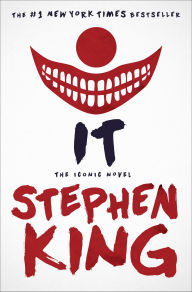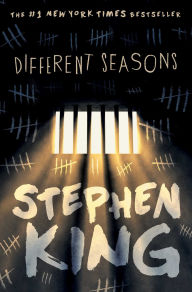The New Adaptation of Stephen King’s It Understands the Horrors of Growing Up
 “Clowns are scary.”
“Clowns are scary.”
It’s a universally accepted hot take these days, a cultural signifier anyone can get behind. Or is it? Setting aside the talents of many hard-working performing clowns, many people still find joy in jesters in wacky makeup.
Not me, though. I was scared of clowns before being clown-scared was cool. Evidence: I was born in Chicago in the years just following the John Wayne Gacy murders, and my parents still saw fit to adorn my bedroom walls with weird oil paintings of clowns and other assorted circus folk. Conversely, I also like to scare myself. That’s why Stephen King’s novel It, the subsequent miniseries, and now the new movie have always had a hold on me.
(I’m also not crazy about spiders, which you’ll understand is relevant if you’re familiar with the novel.)
It: A Novel
It: A Novel
By Stephen King
In Stock Online
Paperback
$22.00
$25.00
This past weekend, Andrés Muschietti’s theatrical adaptation didn’t just break records for a horror-movie opening, it demolished them. King’s novel has an utterly epic length (second only to The Stand in his oeuvre), and a very natural 27-year break in the story, so it’s not surprising a sequel was already in the works. But now it’s a guarantee. It’s certainly a win, not only for the people behind the film, but for King himself: this is the third major adaption of one of his works this year, with The Mist TV series (adapted from a novella in Skeleton Crew) and The Dark Tower both receiving far less enthusiactic responses.
Originally set in the late 50s, the Muschietti version moves the action forward to the late 1980s, losing little, and gaining much for contemporary audiences. As in many small towns, things change slowly in King’s fictional Derry, Maine, then they do elsewhere. Readers will recognize Derry as one of the writer’s three favorite fictional Maine towns, making its second appearance in It. (The first was in “The Body,” the short story from Different Seasons that became the film Stand By Me.) Teenager Bill Denbrough is taking a sick day during a storm, but helps his younger brother Georgie make a paper sailboat sealed with wax. It’s a charming introduction, and clearly going nowhere good. The boat floats into a sewer drain. Thanks in part to the Tim Curry’s iconic turn in the 1990 TV miniseries, what happens next is seared on our collective subconscious. Even knowing that Pennywise the Dancing Clown is about to make his lurid introduction, this new film version still generates tension from the scene, and legitimate horror at Georgie’s (now far more graphic) fate. The boy is lost to the pasty-faced demon who lives in the sewer, and Bill and his family are left to carry on as we flash forward to the end of the school year.
This past weekend, Andrés Muschietti’s theatrical adaptation didn’t just break records for a horror-movie opening, it demolished them. King’s novel has an utterly epic length (second only to The Stand in his oeuvre), and a very natural 27-year break in the story, so it’s not surprising a sequel was already in the works. But now it’s a guarantee. It’s certainly a win, not only for the people behind the film, but for King himself: this is the third major adaption of one of his works this year, with The Mist TV series (adapted from a novella in Skeleton Crew) and The Dark Tower both receiving far less enthusiactic responses.
Originally set in the late 50s, the Muschietti version moves the action forward to the late 1980s, losing little, and gaining much for contemporary audiences. As in many small towns, things change slowly in King’s fictional Derry, Maine, then they do elsewhere. Readers will recognize Derry as one of the writer’s three favorite fictional Maine towns, making its second appearance in It. (The first was in “The Body,” the short story from Different Seasons that became the film Stand By Me.) Teenager Bill Denbrough is taking a sick day during a storm, but helps his younger brother Georgie make a paper sailboat sealed with wax. It’s a charming introduction, and clearly going nowhere good. The boat floats into a sewer drain. Thanks in part to the Tim Curry’s iconic turn in the 1990 TV miniseries, what happens next is seared on our collective subconscious. Even knowing that Pennywise the Dancing Clown is about to make his lurid introduction, this new film version still generates tension from the scene, and legitimate horror at Georgie’s (now far more graphic) fate. The boy is lost to the pasty-faced demon who lives in the sewer, and Bill and his family are left to carry on as we flash forward to the end of the school year.
Different Seasons
Different Seasons
By Stephen King
In Stock Online
Paperback
$16.99
$19.99
The movie amps up the presence of Pennywise, with striking visual effects that only occasionally read as CGI. Even split in two, it would be impossible to fit all of a 1,000 pages of the novel into a single film, but Muschietti and screenwriters Cary Fukunaga, Chase Palmer, and Gary Dauberman stay true to the broad themes.—especially the sense that Pennywise, the fear-eating demonic entity terrorizing the children of the town, is only slightly more terrible than the real-life horrors of growing up, particularly in a small town when you’re not one of the cool kids. Bill, with his gentle demeanor and small stutter, is hardly that. He manages to find friends, and allies, in the form of what comes to be called “The Losers Club:” they’re broad signifiers in a sense, but they’re also pretty good stand-ins for kids most of us knew: the smartass, the nebbish, the library nerd (they’re the original gang from Stranger Things). The movie falls down somewhat in its portrayal of two of the Losers, Mike, who is black, and Beverly, the only girl. This is very much a boys’ story, and largely a white boys’ story. Each of the kids comes with a relatable family tragedy, but King’s novel gives Mike, one of the town’s very few black kids, a Jim Crow-era history missing from the time-shifted version. Changing eras is partly the reason, but Mike’s backstory is also flattened a bit, his bookish quality given to another character. Similarly, Beverly is more distinctly heroic in the novel; the film finds her ultimately needing to be rescued. The characters are saved by actors who bring real depth to the roles, but I couldn’t ignore the missed opportunities.
Fortunately, while the movie avoids one of the book’s more…interesting moments (a protracted sex scene that is weird enough on the page, a lot of mythology surrounding Pennywise is also largely skipped over. It’s not essential to the plot, but if you want more of King’s imaginative backstory, you’ll need to pick up the novel.
The kids in the movie have all faced demons, from the loss of a sibling to sexual abuse. They’re also dealing with genuinely deranged bullies and parents who don’t care, don’t understand, or are actively hostile to their problems. The quaint, charming town is also part of the horror: it’s a small world from which there is no escape, even at home. That clown is scary, no question, but growing up is its own form of hell. As a result, this latest adaption manages to be more than just another dose of ’80s nostalgia. It’s captures what Stephen King understands about childhood—that it is truly terrifying, with the scary clown or without.
But especially with the scary clown. And sewers. Spiders too.
Have you read Stephen King’s It? How did the film compare?
The movie amps up the presence of Pennywise, with striking visual effects that only occasionally read as CGI. Even split in two, it would be impossible to fit all of a 1,000 pages of the novel into a single film, but Muschietti and screenwriters Cary Fukunaga, Chase Palmer, and Gary Dauberman stay true to the broad themes.—especially the sense that Pennywise, the fear-eating demonic entity terrorizing the children of the town, is only slightly more terrible than the real-life horrors of growing up, particularly in a small town when you’re not one of the cool kids. Bill, with his gentle demeanor and small stutter, is hardly that. He manages to find friends, and allies, in the form of what comes to be called “The Losers Club:” they’re broad signifiers in a sense, but they’re also pretty good stand-ins for kids most of us knew: the smartass, the nebbish, the library nerd (they’re the original gang from Stranger Things). The movie falls down somewhat in its portrayal of two of the Losers, Mike, who is black, and Beverly, the only girl. This is very much a boys’ story, and largely a white boys’ story. Each of the kids comes with a relatable family tragedy, but King’s novel gives Mike, one of the town’s very few black kids, a Jim Crow-era history missing from the time-shifted version. Changing eras is partly the reason, but Mike’s backstory is also flattened a bit, his bookish quality given to another character. Similarly, Beverly is more distinctly heroic in the novel; the film finds her ultimately needing to be rescued. The characters are saved by actors who bring real depth to the roles, but I couldn’t ignore the missed opportunities.
Fortunately, while the movie avoids one of the book’s more…interesting moments (a protracted sex scene that is weird enough on the page, a lot of mythology surrounding Pennywise is also largely skipped over. It’s not essential to the plot, but if you want more of King’s imaginative backstory, you’ll need to pick up the novel.
The kids in the movie have all faced demons, from the loss of a sibling to sexual abuse. They’re also dealing with genuinely deranged bullies and parents who don’t care, don’t understand, or are actively hostile to their problems. The quaint, charming town is also part of the horror: it’s a small world from which there is no escape, even at home. That clown is scary, no question, but growing up is its own form of hell. As a result, this latest adaption manages to be more than just another dose of ’80s nostalgia. It’s captures what Stephen King understands about childhood—that it is truly terrifying, with the scary clown or without.
But especially with the scary clown. And sewers. Spiders too.
Have you read Stephen King’s It? How did the film compare?

